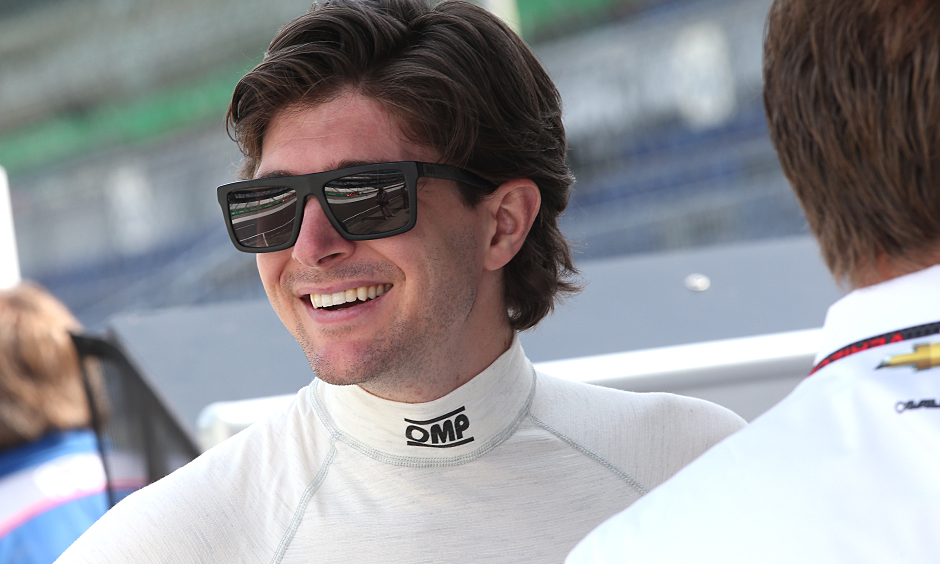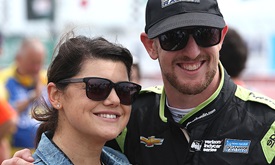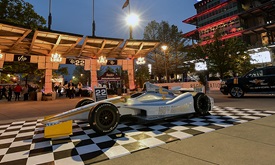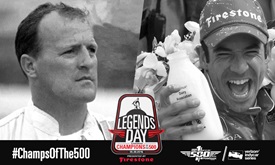INDYCAR Voices: Motorsports primed to make what's virtual a reality
MAY 10, 2016
JR Hildebrand is driver of the No. 6 Preferred Freezer Fuzzy's Vodka Chevrolet for Ed Carpenter Racing at this month's two Verizon IndyCar Series races at Indianapolis Motor Speedway. He is also an INDYCAR Voices columnist.
I’ve spent a fair amount of time over the last couple years exploring immersive technologies, and it’s been a pretty awesome ride.
My first foray as a more serious participant in the space came last year when I joined with an all-star team of people from different backgrounds to create a demo of what Indy car-focused educational programming could look like in virtual reality. You can get a basic sense of that at IndyLabVR.org.
I want to tell you a little about this medium of tech and how I feel it’s poised to fundamentally change the way that you interact with sports like INDYCAR.
In the last couple years, we have seen virtual reality go from tech that seemed like something out of science fiction to a real, tangible technology to which we now have immediate consumer access. Facebook’s $2 billion purchase of Oculus in 2014 was in many ways the catalyst for public recognition of the technology’s relevance. It was a bold move considering the much-anticipated Oculus Rift was only just made available for sale to the public this year, but a strong indicator of things to come.
The VR and AR (augmented reality) segment is projected to be a $120 billion industry by 2020, and you can be sure all the major players are vying for their cut of the pie. Competition is a good thing for us as end users – Samsung’s GearVR headset that runs off a Galaxy smartphone has already halved in cost to just $100, for example, while visual and interactive quality continues to improve across the board. There’s no doubt that VR/AR is an “exponential technology” not unlike digital photography, personal video or smartphones. The freight train is just cresting the hill and about to start picking up steam in a hurry.
I know what you’re thinking: “JR, thanks for the info, but what does this have to do with anything?”
I’ll tell you. It has to do with the future of the experience that you have as a consumer of sports, and in some ways, particularly motorsports. Go with me on this for a minute.
What is the thing that you want most when you attend a sporting event? For me it’s access. I want to be able to walk on the field at AT&T Park while the San Francisco Giants are taking batting practice, I want to be standing there feeling the ground shake as 11 defenders chase Andrew Luck down the sideline and push him out of bounds and, when I think about the Verizon IndyCar Series, I want to be standing next to the timing stand as the No. 9 crew guys bust out their final pit stop and Scott Dixon smokes the tires out of the box to leapfrog the leader. I want to get behind the scenes. I want to feel like I’m a part of it, like I’ve got an insider’s view of the action. Who doesn’t?
In reality, this is nearly impossible. Even with the absolute best seats in the house, you’re still an observer from the outside, all-access passes or not. There is a boundary to where you can go and how close you can get.
In some ways, television addresses this in being able to show you what’s going on in these otherwise inaccessible places. TV allows us to get all this added information that you don’t get at the actual event because there are people as a part of the broadcasts that do have all the access you want. The shortcoming here is that, no matter how big, you’re still viewing it all on a rectangular box that’s dictating to you what you see. You have no personal control – what you view from a particular place is being decided for you.
What if you had access to all of these behind-the-scenes places, these heat-of-the-moment situations, and actually felt like you were there?
That is the promise of virtual reality. Well-produced VR experiences can quite literally make your subconscious mind believe that you are in another place. This sense of “presence” is created by your ability to look around in a spherical 360-degree environment – if that environment is generated properly either in computer graphics or with 360-degree video, your brain simply trusts the optical and auditory signals it’s receiving as it normally would.
This significantly differentiates the experience between watching a two-dimensional screen (even if it’s a giant TV or even 360 video like you may have seen on YouTube and Facebook) and a legitimate VR experience in a headset. In a headset you are literally immersed in your 360-degree environment, as if you are standing in the exact position in space where the camera rig is placed at a faraway event. You can look up, look down and all around you, with a real-life sense of your depth of field, movement and sound.
There are all kinds of specific-use cases for why this is an exciting development in technology, but I feel the motorsports segment is a particularly interesting one. To start, you could gain all the same levels of access and presence in cool places as any other sport basically. Garage area, pit lane, the grid, race control, various locations on track, etc. You could even get all the real behind the scenes stuff – wind-tunnel testing IN the wind tunnel, simulator testing WITH the driver and so on. But motorsport has one thing that’s very unique and especially interesting in the context of VR and feeling like you’re really there – the onboard position.
Imagine the battle between Ryan Hunter-Reay and Helio Castroneves for the Indianapolis 500 win in 2014. The onboard camera angles are cool, but again, like all TV, there’s a guy in the production trailer who is ultimately deciding what’s interesting to you and directing your attention there.
Now imagine the same situation in VR with a good user interface platform. You have control over which car you want to be onboard with, you can decide at any point to swap between the two leaders as they battle it out with it all on the line, and you can always, at any time, look all around you to take in the ENTIRE moment. You will feel like you’re a part of the action; like you’re a part of Ryan’s insane pass into Turn 3, like you’re that little boost that might help Helio draft back past coming to the checkered as the engines’ 12,000 rpm and 225 mph wind noise attack your eardrums.
I would argue this is an experience you might never get in a long list of other sports. I don’t think you’ll see every NFL player out there with a 360 video rig on their helmet or baseball players with them on their caps. At least until the hardware in this category takes a leap by an order of magnitude, motorsport has a very clear advantage here in terms of adoption.
And really, all we’ve touched on is the start. These are the things that be executed now, or are being explored. We are additionally near a cusp where gaming, VR and live events could all intersect, and that is where things start to really get crazy.
Racing against all your favorite drivers, based on their actual GPS locations on a racetrack at that exact time using live telemetry, while also competing online or against your friends, all in a feels-like-you’re-actually-there immersive experience?
It’s not as far off as you might think.



















